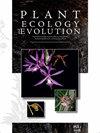Molecular phylogeny of Atractocarpus (Rubiaceae): taxonomic implications for several New Caledonian Gardenieae species
IF 1.1
4区 生物学
Q3 PLANT SCIENCES
引用次数: 1
Abstract
Background and aims – New Caledonia is a hotspot of biodiversity in the world. Among the most diverse New Caledonian plant families is Rubiaceae, which consist of 30 genera containing 220 species, with a level of endemism of 93%. The tribe Gardenieae is represented by four genera, Gardenia (8 species), Aidia (2 species), Randia (7 species), and Atractocarpus (10 species). As Randia has now been restricted to the Neotropics, the New Caledonian Randia species remain unplaced within the tribe. Atractocarpus is a Pacific genus, easily characterized by long imbricated stipules, a feature also present in the Randia species and in several Gardenia species in New Caledonia. The aims of the present study are to test the monophyly of Atractocarpus and to assess the phylogenetic placement of the Randia and Gardenia species with long imbricated stipules within Gardenieae and specifically their relationships with taxa of the Porterandia group to which Atractocarpus belongs. Material and methods – We investigated 63 species of Pacific Gardenieae, with a focus on the Porterandia group, in a Bayesian phylogenetic reconstruction (cpDNA: trnTF and rpl32, and nrDNA: ITS). Key results – Our study provides a mostly supported consensus tree topology of the Porterandia group. Five Gardenia and seven Randia species fall within a clade that comprises the New Caledonian Atractocarpus species, rendering both Atractocarpus and Gardenia polyphyletic. Conclusion – We enlarge the delimitation of Atractocarpus to include 12 New Caledonian Randia and Gardenia species. New Caledonia is consequently confirmed as the centre of diversity for Atractocarpus with 31 species. According to our study, three genera of Gardenieae occur in the archipelago: Aidia, Gardenia, and Atractocarpus.白术属(茜草科)的分子系统发育:几个新喀里多尼亚栀子属物种的分类学意义
背景和目标——新喀里多尼亚是世界生物多样性的热点。在新喀里多尼亚最多样化的植物科中,茜草科由30属220种组成,特有性水平为93%。Gardenieae部落有四个属,即Gardenia(8种)、Aidia(2种)、Randia(7种)和Atractocapus(10种)。由于Randia现在被限制在新热带地区,新喀里多尼亚Randia物种在部落中仍然没有分布。白术属是一个太平洋属,很容易以长的叠瓦状托叶为特征,这一特征也存在于新喀里多尼亚的Randia物种和几个Gardenia物种中。本研究的目的是测试白术的单系性,并评估具有长叠瓦托叶的Randia和Gardenia物种在栀子科中的系统发育位置,特别是它们与白术所属Porterandia类群的关系。材料和方法——我们在贝叶斯系统发育重建(cpDNA:trnTF和rpl32,以及nrDNA:ITS)中调查了63种太平洋栀子,重点是Porterandia组。关键结果——我们的研究提供了Porterandia群最受支持的一致树拓扑。五个栀子属和七个兰迪亚属物种属于一个分支,该分支包括新喀里多尼亚白术属物种,使白术属和栀子属均为多系。结论:我们扩大了白术属的范围,包括12个新喀里多尼亚兰属和栀子属物种。新喀里多尼亚因此被确认为白术的多样性中心,共有31个物种。根据我们的研究,栀子科有三个属:艾迪亚属、栀子属和白术属。
本文章由计算机程序翻译,如有差异,请以英文原文为准。
求助全文
约1分钟内获得全文
求助全文
来源期刊

Plant Ecology and Evolution
PLANT SCIENCES-
CiteScore
2.20
自引率
9.10%
发文量
27
审稿时长
>12 weeks
期刊介绍:
Plant Ecology and Evolution is an international peer-reviewed journal devoted to ecology, phylogenetics and systematics of all ‘plant’ groups in the traditional sense (including algae, cyanobacteria, fungi, myxomycetes), also covering related fields.
The journal is published by Meise Botanic Garden and the Royal Botanical Society of Belgium.
 求助内容:
求助内容: 应助结果提醒方式:
应助结果提醒方式:


